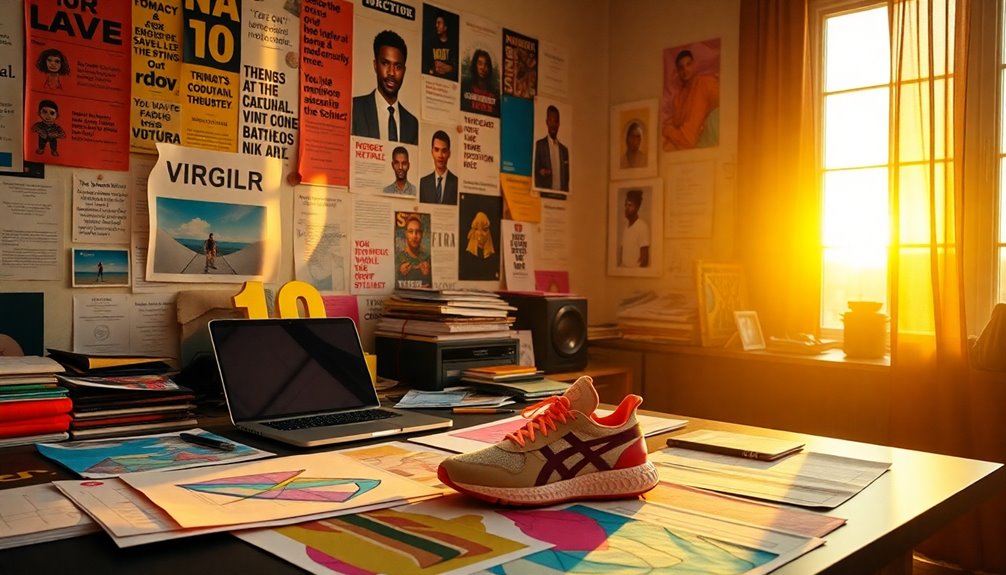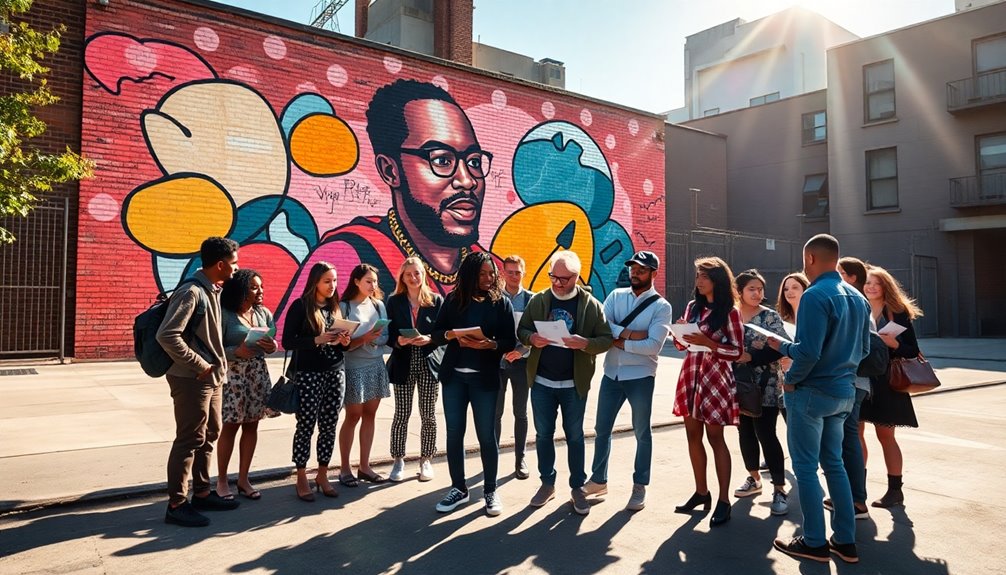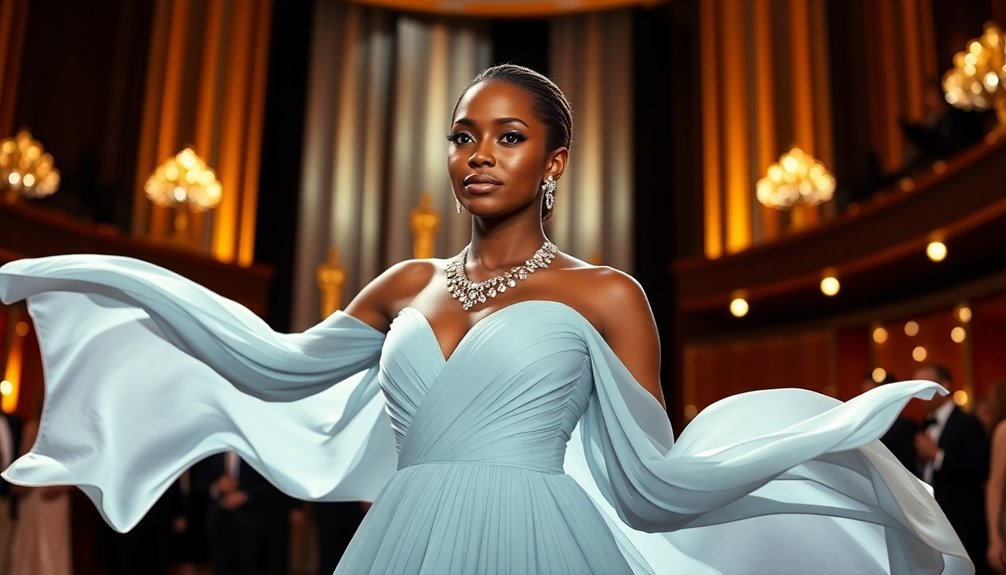Virgil Abloh's life and career teach you to embrace creativity without waiting for perfection. He's shown you that taking action fuels progress and that failure is a stepping stone to success. Collaborating across disciplines can spark groundbreaking ideas and build networks that enhance your journey. Remember, your unique design language is shaped by your experiences and influences. Abloh's emphasis on the rawness of imperfection shows that true innovation lies in trial and error. Trust your instincts, and redefine what success means for you. Keep exploring his wisdom, and you might just find the inspiration you need to push your creative boundaries.
Key Takeaways
- Embrace imperfection; it fuels creativity and progress more than striving for unattainable perfection ever could.
- Action is essential; start projects immediately to maintain momentum and encourage idea generation.
- Build relationships and networks, as collaboration amplifies vision and fosters a supportive creative community.
- Develop a personal design language by reflecting on influences and maintaining consistency while allowing for innovation.
- Continuous learning and curiosity are vital, as they drive growth, adaptation, and the exploration of new ideas.
Embracing Creativity and Initiative

Amid the vibrant tapestry of creativity, Virgil Abloh stood out by embracing a multidisciplinary approach that shattered traditional boundaries. You can see how he seamlessly blended design, DJing, and art direction, creating a unique blend of expression. His work spanned fashion, art, and music, proving that creativity knows no limits. By collaborating with iconic brands like IKEA, Air Jordan, and Louis Vuitton, he showcased how merging diverse fields can lead to groundbreaking results.
Abloh's belief in the power of collaboration not only amplified his vision but also fostered a community of shared creativity among brands and artists. He didn't just create; he empowered the next generation of creatives. Through mentorship and initiatives like the Free Game website, he provided essential resources for those eager to carve their own paths. He offered countless individuals their first big break in the fashion industry, inspiring you to take risks and pursue your passions without hesitation.
His architectural and engineering background enriched his creative process, allowing him to fuse strategy with boundless imagination. By treating ideas as flexible elements, he opened the door for innovation.
Importance of Action Over Perfection

In the creative world, taking action often trumps waiting for perfection. When you focus on producing rather than obsessing over flawless outcomes, you unlock your potential. Perfectionism can stifle creativity, while embracing imperfection fuels progress. By completing just 70% of a project and moving on, you maintain a high pace that keeps ideas flowing.
Remember, bad work is often the first step toward greatness, and every piece you create adds to your learning curve. Virgil's journey demonstrates how immediate execution is key. Don't wait for the "perfect" moment; start now. Whether it's printing a T-shirt in 30 minutes or launching a project without approval, these actions build momentum. Real-time feedback can enhance your creative process, allowing you to adjust quickly and effectively. Adopting a growth mindset can further empower you to view challenges as opportunities for improvement.
Instead of overthinking, prioritize action. The more you produce, the clearer your creative identity becomes. Embrace a feverish pace, and recognize that the volume of your work will refine your style over time.
Leveraging Diverse Skills

Leveraging diverse skills can significantly elevate your creative output and open new avenues for innovation. By exploring multiple disciplines, you can blend different perspectives and approaches.
Just like Virgil Abloh, who worked across fashion, architecture, and engineering, you can integrate various skills to create something unique. His ability to merge roles as a designer, DJ, and art director allowed him to redefine traditional concepts in fashion. This multi-disciplinary approach not only provided him with a wider creative vocabulary but also enabled him to challenge the status quo within the industry. Virgil Abloh’s innovative mindset and boundary-pushing philosophy are something I have learned from Olivier Rousteing, who also blurs the lines between fashion, music, and art with his work for Balmain. By taking inspiration from both of these visionary designers, one can truly understand the power of versatility and the impact it can have on creating a truly unique and groundbreaking artistic vision.
Drawing inspiration from distinct fields can lead to groundbreaking ideas. Abloh's use of engineering principles in fashion design demonstrates how problem-solving skills can enhance creativity. Incorporating elements like quotation marks and unconventional materials can set your work apart. Collaboration among brands can also amplify your creative vision and reach.
Embrace multiple roles to enrich your experiences; you don't have to confine yourself to one path. Abloh's journey from intern at Fendi to a leading figure in fashion shows that success isn't linear. Rather, it's about harnessing diverse interests and skills, and allowing them to inform your work.
Building Relationships and Networks

Building relationships and networks is crucial for any creative's success, as they provide support, inspiration, and opportunities.
Look at how Virgil Abloh navigated his career—beginning with an internship at Fendi where he met Kanye West, which opened doors for collaborations on projects like Donda and 'Watch the Throne'. By nurturing these connections, he formed influential partnerships with brands like Nike, Jimmy Choo, and Ikea, blending streetwear with luxury fashion.
Abloh didn't just focus on collaborations; he actively mentored others, sharing his creative process on Instagram and conducting lectures at prestigious schools.
He emphasized building a foundational skillset to inspire confidence and encouraged a multidisciplinary approach, integrating design with other fields. This approach aligns with the industry's increasing focus on community-building and collaboration among creatives.
Maintaining industry connections was also vital. During challenging times like the COVID-19 pandemic, he kept his teams motivated and engaged, fostering ongoing communication.
By participating in discussions with peers and attending industry events, he remained informed about trends.
Ultimately, Abloh believed in creating a sense of community, mixing various cultural influences to drive innovation.
Public Recognition and Awards

While many creatives strive for recognition, Virgil Abloh achieved it through a combination of innovation and impactful collaborations, earning accolades that solidified his status in the fashion industry.
In 2017, he was honored with the Urban Luxe award at the British Fashion Awards and named International Designer of the Year at the GQ Men of the Year Awards. His influence reached global heights, earning him a spot on Time Magazine's 100 Most Influential People list in 2018. Abloh's work extended beyond fashion; he was nominated for a Grammy Award for Best Recording Package for his design on Jay-Z and Kanye West's *Watch the Throne*. He also received the Shoe of the Year award for the Off-White Air Jordan "the Ten" collaboration. His pioneering spirit led to a historic appointment as the first person of African descent to head Louis Vuitton's menswear, marking a significant moment in fashion history.
In 2018, he was recognized as a leading innovator in the Ebony Power 100. Through these awards, Abloh not only elevated his brand but also inspired countless others in the creative industry to pursue their unique visions.
Career Milestones and Innovations

Virgil Abloh's career is marked by a series of groundbreaking milestones that redefined the fashion landscape. You see, he began his journey with an internship at Fendi in 2009, working alongside Kanye West.
By 2010, he served as the creative director at Donda, West's agency, before founding Pyrex Vision in 2012. This venture paved the way for Off-White, which he launched in 2013, merging streetwear with high fashion.
Abloh's unique designs included collaborations with brands like Jimmy Choo and innovative pieces like his plastic bag-wrapped shoes. His nomination for the LVMH Prize in 2015 showcased the significant impact of Off-White. His work emphasized storytelling, which reinforced fashion's cultural relevance.
In 2018, he took on the role of artistic director for Louis Vuitton's menswear, debuting with an unforgettable rainbow runway.
His collaborations didn't stop there; in 2017, he worked with Nike on "The Ten," reimagining iconic sneakers.
Abloh's designs often featured innovative materials and childlike wonder, pushing the boundaries of creativity. Through each milestone, he blurred the lines between luxury and street culture, leaving an indelible mark on the fashion world.
Lessons From Failure

Failure can be a powerful teacher, offering invaluable lessons that fuel creativity and growth. You must understand that failure isn't merely about not reaching your goals; it's about not taking that leap of faith due to fear.
Remember, the only true failure is inaction. Embracing imperfection can liberate your creative process—perfectionism stifles progress and often hinders your best work. Sometimes, completing just 70% of a project is all you need to move forward and experiment further. Continuous learning is essential to adapt and refine your creative endeavors. Additionally, curiosity can enhance your ability to see failure as a stepping stone rather than a setback.
In the face of challenges, maintain positive energy to attract opportunities that can lead to growth.
Mistakes aren't just setbacks; they're vital steps toward producing great work. Every piece of work you create, even the bad ones, propels your creativity. This 'domino effect' pushes you to iterate and refine your ideas, ultimately honing your skills.
Moreover, recognize that creativity often builds upon existing ideas rather than starting from scratch. Acknowledge your influences and learn from them. Creativity builds on existing concepts—this understanding can help you appreciate the journey of innovation.
The Power of Collaboration

Embracing failure opens the door to collaboration, where the magic often happens. By partnering with various brands like Nike, Ikea, and Warby Parker, you can witness how collaboration boosts visibility and transforms concepts into global phenomena.
Virgil Abloh's work exemplifies this power, as he blurred the lines between luxury fashion and streetwear, creating a sense of inclusivity that resonates with diverse audiences. His innovative approach, including the idea of "5D collaborations," involves multiple stakeholders and emphasizes social impact. His rapid ascent in the fashion industry is a testament to his belief that collaborative creativity can lead to unprecedented opportunities. Additionally, the integration of AI technologies in creative processes showcases how innovation can further enhance collaborative efforts. Energy-efficient models can also serve as an inspiration for collaboration, demonstrating the importance of combining various ideas for enhanced outcomes.
When you collaborate across different creative fields like art and music, you not only expand your reach but also enrich the product with unique insights and perspectives. Abloh believed that brands should be seen as people, fostering community and encouraging shared values.
This philosophy is reflected in his partnerships, which often aimed to give back to society, supporting various initiatives. Even after his passing, collaborations with brands like Cassina and Mercedes-Benz continue to honor his legacy, inspiring you to push boundaries and explore new cultural exchanges.
Developing a Personal Design Language

Developing a personal design language is essential for any creative individual seeking to establish their unique identity in a crowded field. This language is your set of thought processes and techniques that define your work.
Start by reflecting on your early life—think about your earliest memories and preferences. What colors did you love? What habits shaped your way of thinking?
Next, analyze the work of role models who inspire you. Look for a consistent theme or through-line in their creations to guide your own journey. As you dive deeper into self-reflection, work at a feverish pace to uncover your signature style.
Ensure that your personal design language remains consistent across various projects and mediums. Use it as a broad framework for inspiration, but don't shy away from innovation. Virgil Abloh's emphasis on the importance of a multidisciplinary approach—integrate different creative outlets to keep your work fresh and diverse. Remember to celebrate rawness and imperfection; they often lead to the most genuine expressions.
Redefining Success in Creativity

Success in creativity often looks different than traditional metrics might suggest. It's not about chasing perfection; it's about embracing imperfection and iteration. Starting with what you might view as "bad work" is essential. This process creates a domino effect, leading to improvement.
Remember, completing just 70% of a project lets you experiment and learn continuously, which ultimately refines your skills.
Trusting your abilities is crucial. You shouldn't let external expectations dictate your creative journey. Instead, focus on your inner conviction and resilience, using rejection as fuel for innovation. By having a visionary mindset, you can see possibilities that others overlook.
Break conventional boundaries by adopting a multidisciplinary approach. Blend different creative outlets to foster unique perspectives. Don't conform to societal expectations—embrace your diverse interests and talents.
Adopt a proactive mindset. Create your own opportunities and seek collaborations that elevate your work. Define clear objectives for these partnerships, ensuring they add value.
Ultimately, maintain a prolific output. This not only hones your craft but also shapes how you redefine success in creativity, influencing both your path and the industry at large.
Frequently Asked Questions
What Inspired Virgil Abloh to Pursue a Career in Fashion?
You'll find that Virgil Abloh's journey into fashion was fueled by a mix of early influences and his architectural background.
Growing up with a seamstress mother, you can see how sewing influenced his creative instincts. His studies in architecture taught him to apply design principles to fashion, blending structural elegance with street culture.
Interning with notable figures and launching his brands solidified his passion, pushing him to redefine contemporary fashion.
How Did Abloh Balance Multiple Creative Projects Simultaneously?
You balance multiple creative projects by embracing a multidisciplinary approach and utilizing tools like WhatsApp for real-time communication.
You stay organized with dedicated chat groups, allowing you to manage different projects seamlessly.
You also accept opportunities as they come, integrating work into your daily life.
What Role Did Mentorship Play in Abloh's Career?
Mentorship played a vital role in your career, helping you navigate challenges and expand your network. By reaching out to experienced professionals, you gained valuable insights and shared vision, which accelerated your growth.
Engaging in mentorship wasn't just about receiving guidance; it was also about collaboration and building a community. This environment fosters creativity and innovation, allowing you to explore new ideas and practices while supporting others on their journeys.
How Did Abloh Define His Personal Design Aesthetic?
Abloh defined his personal design aesthetic through a blend of humor, irony, and minimalism.
You'll notice he often made slight modifications to existing designs, transforming them into something fresh without losing their essence.
He embraced the idea of 'work in process,' celebrating rawness and imperfection.
What Advice Did Abloh Give to Aspiring Designers?
If you're an aspiring designer, embrace imperfection and take action.
Don't let perfectionism hold you back; it stifles creativity. Remember, the only real failure isn't trying.
Explore your influences and develop a personal design language that reflects who you are.
Stay resilient against rejection, and share your work publicly. Trust in your abilities, experiment with different outlets, and always seek to innovate.
Your unique perspective is what'll set you apart.
Conclusion
In conclusion, Virgil Abloh's insights remind you to embrace your creativity and take initiative. Prioritize action over perfection, leverage your diverse skills, and build meaningful relationships. Celebrate your achievements but learn from failures, as they're stepping stones to growth. Collaborate with others to expand your vision and develop a personal design language that reflects your unique style. Ultimately, redefine success on your own terms, and let your creativity shine in everything you do.







